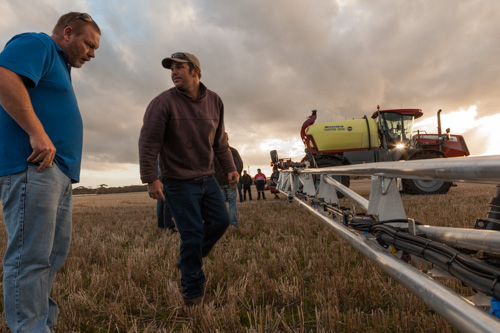Spraying at night - minimising the risks - Part 1
Most broadacre growers want the capacity to spray their whole farm within about a ten day period or less if possible. Generally the first way to get more spraying done in a limited time period is to spray at night. The widespread adoption of auto-steer and tram-tracking has meant that spraying at night is easier to do, thus giving more hours spraying per day.
Night spraying has also been promoted as giving better weed control because it is cooler with higher humidity so target weeds will be less stressed. This however is not always the case and anyone looking at meteorological data over a 24 hour period in summer will see that meteorological conditions may not necessarily differ much between night and day.
 There is a lot of preparation for successful, low risk night spraying. Image:AGRONOMOThis first article on night spraying discusses the issues encountered if there isn’t a surface temperature inversion. The second part will discuss surface temperature inversions and why they are bad news for spraying.
There is a lot of preparation for successful, low risk night spraying. Image:AGRONOMOThis first article on night spraying discusses the issues encountered if there isn’t a surface temperature inversion. The second part will discuss surface temperature inversions and why they are bad news for spraying.
No inversion, so you think you are covering the bases?
Despite trying to do all the right things such as using a coarser droplet spectrum with matching application volume and keeping within the ground speed limits of your sprayer significant drift can occur with night spraying. Night spraying can deposit 5 times the amout of spray into the air compared with spraying diring daylight hours.
To demonstrate what can happen I will discuss research conducted by Bill Gordon Consulting in northern NSW comparing drift from night versus day spraying.
A 55 ha paddock was sprayed at 2:30 am and again at 7:30 am using a 36 m boom travelling at 22 kph, with Teejet AIXR 11002 nozzles, 50 L/ha at 4 bar producing a coarse spray quality.
Herbicide drift was measured 80 m downwind of the paddock using a 20 m high collection tower.
The experiment showed that less than 0.5% of total spray applied to the paddock was collected at the tower during the daylight application compared with 1.5% from the night application. This means there was virtually one hectare’s worth of spray heading downwind from the sprayed paddock at night despite the “acceptable” spray conditions. Looking at the meteorological data below there was little difference between the two application times.
Table 1: Meteorological conditions at time of spraying
|
|
Wind Speed (km/hr) |
Wind Direction (°) |
Temperature (°C) |
Relative Humidity (%) |
|
Night (2:30 am) |
12 |
19 |
26 |
64 |
|
Day (7:30 am) |
18 |
4 |
29 |
61 |
Despite there being no surface temperature inversion there was still 3 times the spray in the air moving downwind at night. Higher daytime wind speed would have created more mixing of the air and forced droplets down to the target compared with night spraying.
The other thing to consider is it isn’t just what you do, but the cumulative effects of other sprayers in the local area. Often neighbours will be spraying at night launching small amounts of spray into the air which can accumulate in downwind areas of the landscape and becomes a much bigger problem to sensitive vegetation in those areas.
How to reduce the problems with night spraying?
- DO NOT spray during a surface temperature inversion.
- Keep measuring meteorological conditions during spraying and stop spraying if conditions deteriorate. Have a pre-determined cut-off for when you will stop.
- Use extremely coarse (XC) spray quality – in this experiment XC spray quality would have reduced drift to 0.5% for the same conditions. Keep in mind the suitability of these coarse droplets on the target and the product to be used and the need to go to increase application volume as spray quality becomes coarser.
- Slow down and keep boom height to a minimum – higher speeds increase the volume of finer droplets being lifted behind the machine creating a plume of spray lifting 15 to 20 m into the air. Higher speeds usually means lifting the boom. Lifting boom height from 50 to 70 cm above the target increases drift potential 4 times while going from 50 to 100 cm increases it 10 times.
- Only spray paddocks with good catch surfaces, such as stubble or dense vegetation.
- Make sure you know if there are sensitive areas downwind.
 Spraying paddocks with poor droplet catch surfaces like this will increase the likelihood of spray drift, especially with night spraying. Image: AGRONOMO
Spraying paddocks with poor droplet catch surfaces like this will increase the likelihood of spray drift, especially with night spraying. Image: AGRONOMO
The next blog will explain surface temperature inversions and why most labels state that you are not to spray if an inversion has formed.
